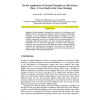Free Online Productivity Tools
i2Speak
i2Symbol
i2OCR
iTex2Img
iWeb2Print
iWeb2Shot
i2Type
iPdf2Split
iPdf2Merge
i2Bopomofo
i2Arabic
i2Style
i2Image
i2PDF
iLatex2Rtf
Sci2ools
DILS
2004
Springer
2004
Springer
On the Application of Formal Principles to Life Science Data: a Case Study in the Gene Ontology
Formal principles governing best practices in classification and definition have for too long been neglected in the construction of biomedical ontologies, in ways which have important negative consequences for data integration and ontology alignment. We argue that the use of such principles in ontology construction can serve as a valuable tool in error-detection and also in supporting reliable manual curation. We argue also that such principles are a prerequisite for the successful application of advanced data integration techniques such as ontology-based multi-database querying, automated ontology alignment and ontology-based text-mining. These theses are illustrated by means of a case study of the Gene Ontology, a project of increasing importance within the field of biomedical data integration.
| Added | 01 Jul 2010 |
| Updated | 01 Jul 2010 |
| Type | Conference |
| Year | 2004 |
| Where | DILS |
| Authors | Barry Smith, Jacob Köhler, Anand Kumar |
Comments (0)

